Chicken stock is a cooking staple. For everyone who cooks with it regularly, it pays to have a reliable recipe so you can easily make a large batch of chicken stock at home. Homemade chicken stock is preferable to store-bought in many ways, and I’m showing you how to add layers of complex flavor to your stock, without extra work.
This stock can be made 4 days ahead of time. Then you simply cover and chill, or freeze for up to 6 months.
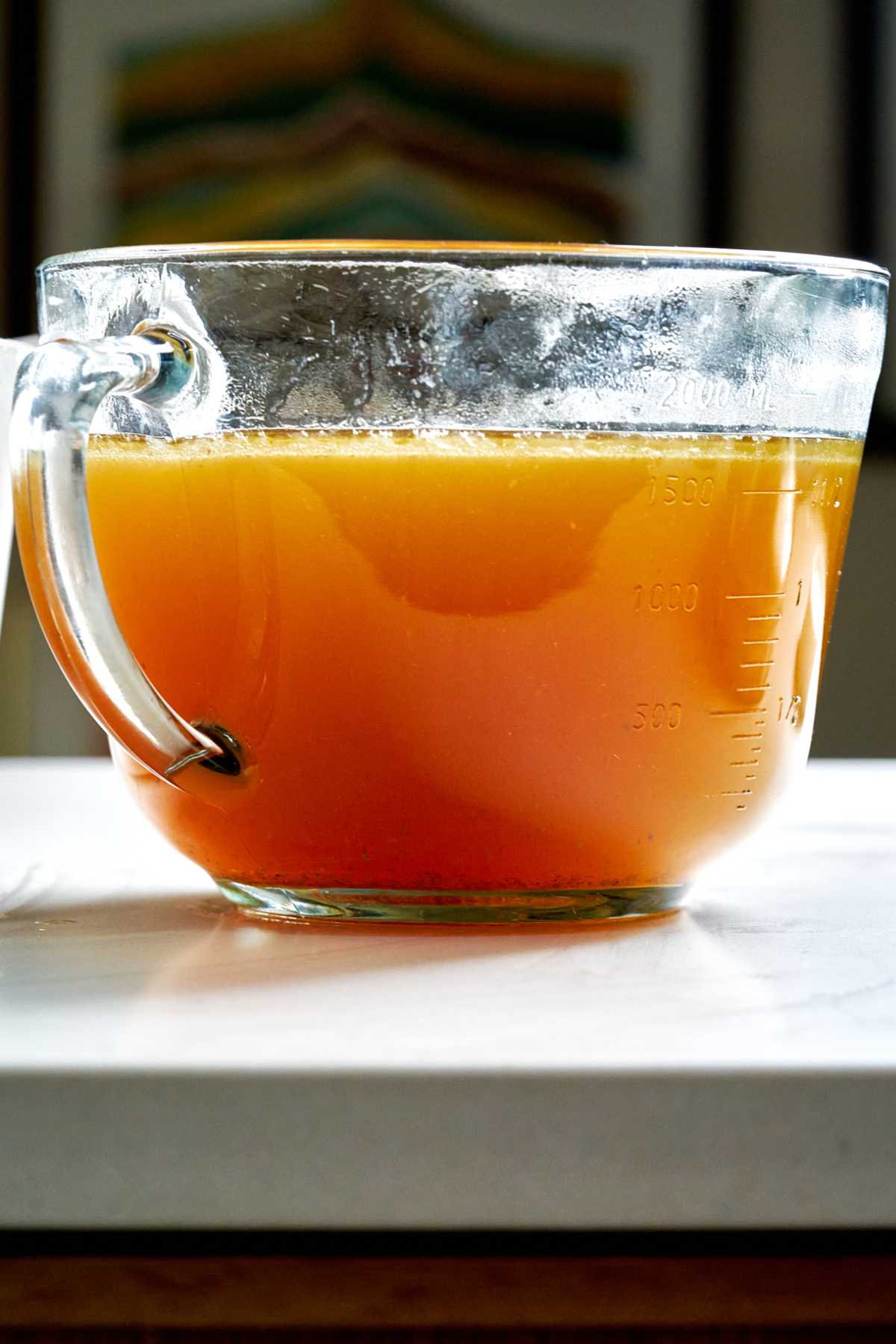
Pro Tips for Making Homemade Chicken Stock
Making your own chicken stock is easy, and doing so has many benefits. Here are my top 6 reasons to make this chicken stock recipe.
- This recipe shows you how to make an outstanding stock with any leftover chicken bones or food scraps. Ask a butcher for extra chicken bones to add to your stock and enhance the flavor.
- Don’t over-simmer the stock past the 48-hour mark.
- In this recipe, aromatic ingredients like the fennel, bay leaves, jalapeño, and peppercorns act as superb flavor enhancers and make the stock really ‘wow’!
- You can control how much salt is in the stock.
- You can make a big batch to store & use over time. Stock can be made 4 days ahead. Cover and chill, or freeze for up to 6 months.
- Depending on your preference, you can make it on the stovetop, in an Instant Pot, or a slow cooker. And all three versions yield a delicious, homemade chicken stock, so use what you already have.
Ingredients & Substitutions
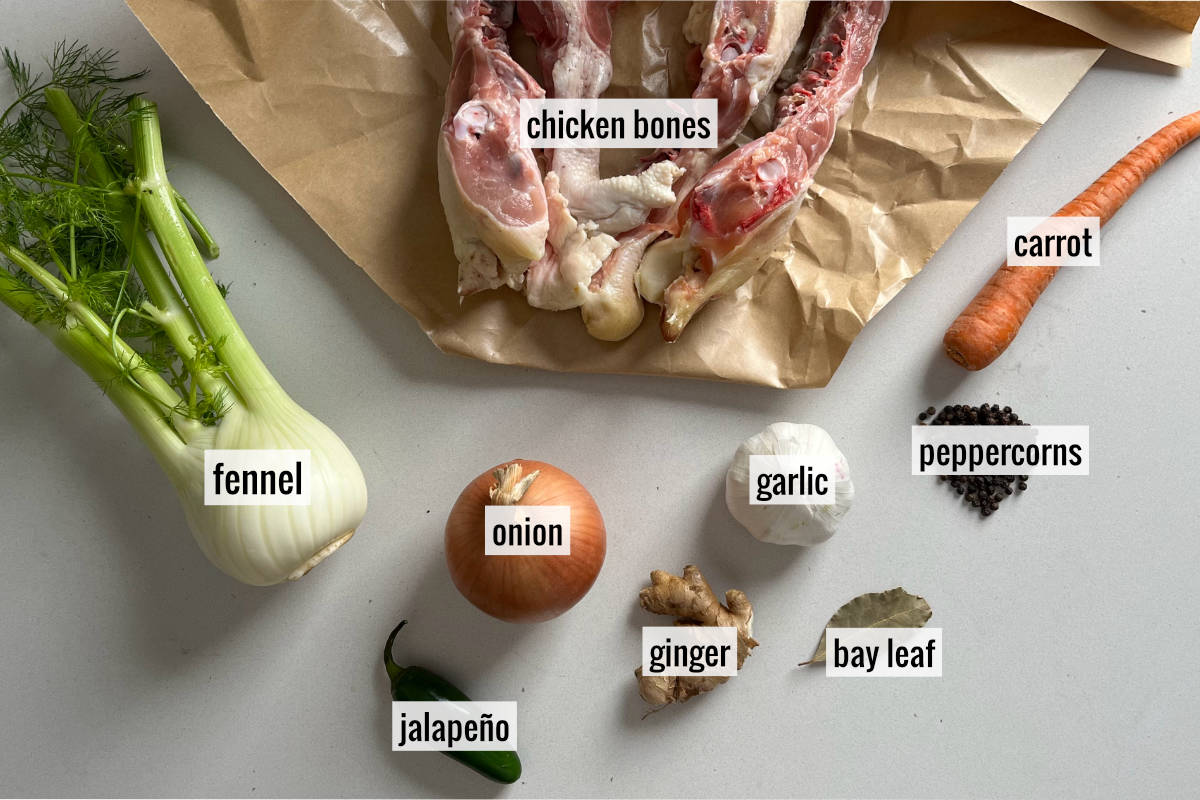
Note on choice of vegetables: You can make this recipe with any vegetable scraps you have like carrot tops, onion peels, potato peels, and more. Feel free to leave out any of the ingredients if they are not to your liking. You can make this recipe with just onion, carrots, and celery for a classic stock.
Chicken or chicken bones – I use chicken backbones left over from when I make a spatchcock chicken. You can also purchase them at your butcher for around 1/3 or less than the price of chicken. You can also use a leftover chicken from a cooked whole bird.
Fennel – This ingredient has a licorice-like flavor that adds a subtle depth of flavor enjoyed by licorice and non-licorice lovers alike.
Black peppercorns – I use whole peppercorns in this recipe because they hold up to being cooked in the stock for a long time without adding to the foam that is created. You can use cracked pepper, too.
Garlic & Onion – We leave the skin on these two items because they add to the flavor and color of the stock. Everything gets strained out, so you will not be eating them.
Jalapeño – This adds a little kick that I love in my chicken stock, but isn’t for everyone. It is optional, or you can use half if you want to minimize the heat.
Salt – I choose to make this stock without salt so I can add it to my liking for each recipe I use it for. However, you can add 1/2-1 tablespoon of salt if you prefer. You can also season it with soy sauce after it’s made.
Where can I get chicken bones for stock?
Every time I buy a whole chicken, I remove the backbone (you can ask your butcher to do this for you) and I collect those bones in a gallon-sized Ziploc bag in my freezer. When making your stock, you can throw in any leftover chicken parts like feet, bones, or even full chicken carcasses from leftover cooked chicken.
When the bag gets 4-6 backbones in it, I’m ready to make some stock!
You can often buy cattle and chicken bones for almost nothing at your butcher shop. Some places even end up throwing them away. So go ahead, just ask, and rescue all that deliciousness!
Make Chicken Stock on the stovetop
Add all your chicken bones and vegetable ingredients to a stock pot. Make sure the pot can hold at least 6 quarts, preferably 8.
Cover all the ingredients with water. Bring the water to a boil, then reduce until it’s lightly simmering. Spoon off any foam that arises to the surface.
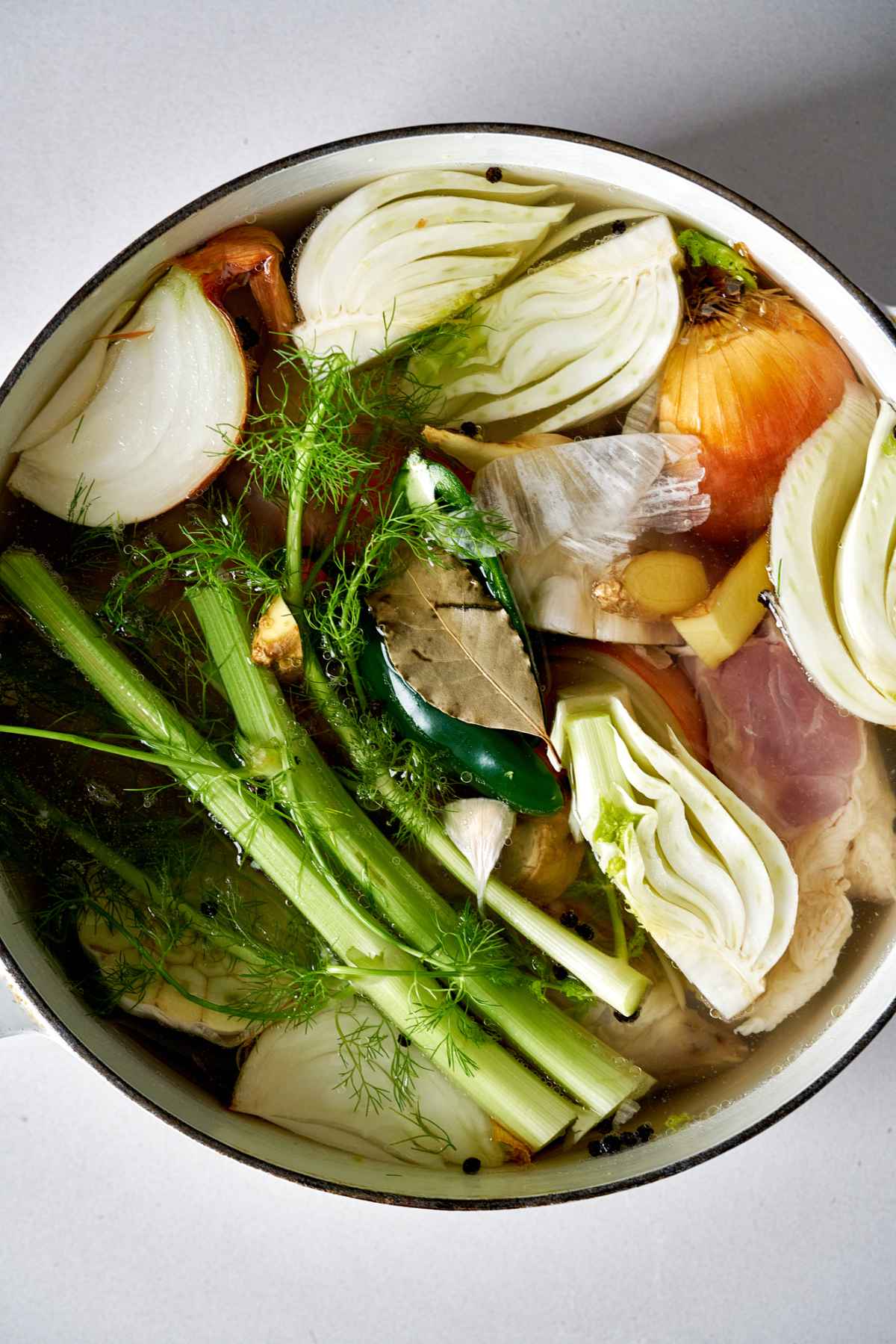
Cover with the lid of the stock pot and leave for a minimum of 4 hours, and up to 48 hours. I have found my preference is around 20 hours.
Take care not to over-simmer. Simmering for a long time is beneficial up to a point, but cooking for longer than 48 hours might result in the flavor becoming bitter and tasting a bit off, in general.
Make sure to monitor the water reduction and add more when necessary – there should always be at least a few quarts of liquid in the pot. You can do taste tests every few hours after the first 4 hours for the flavor you want to achieve.
If you’re making this recipe salt-free, keep that in mind during the taste tests. I prefer to season it as I use it.
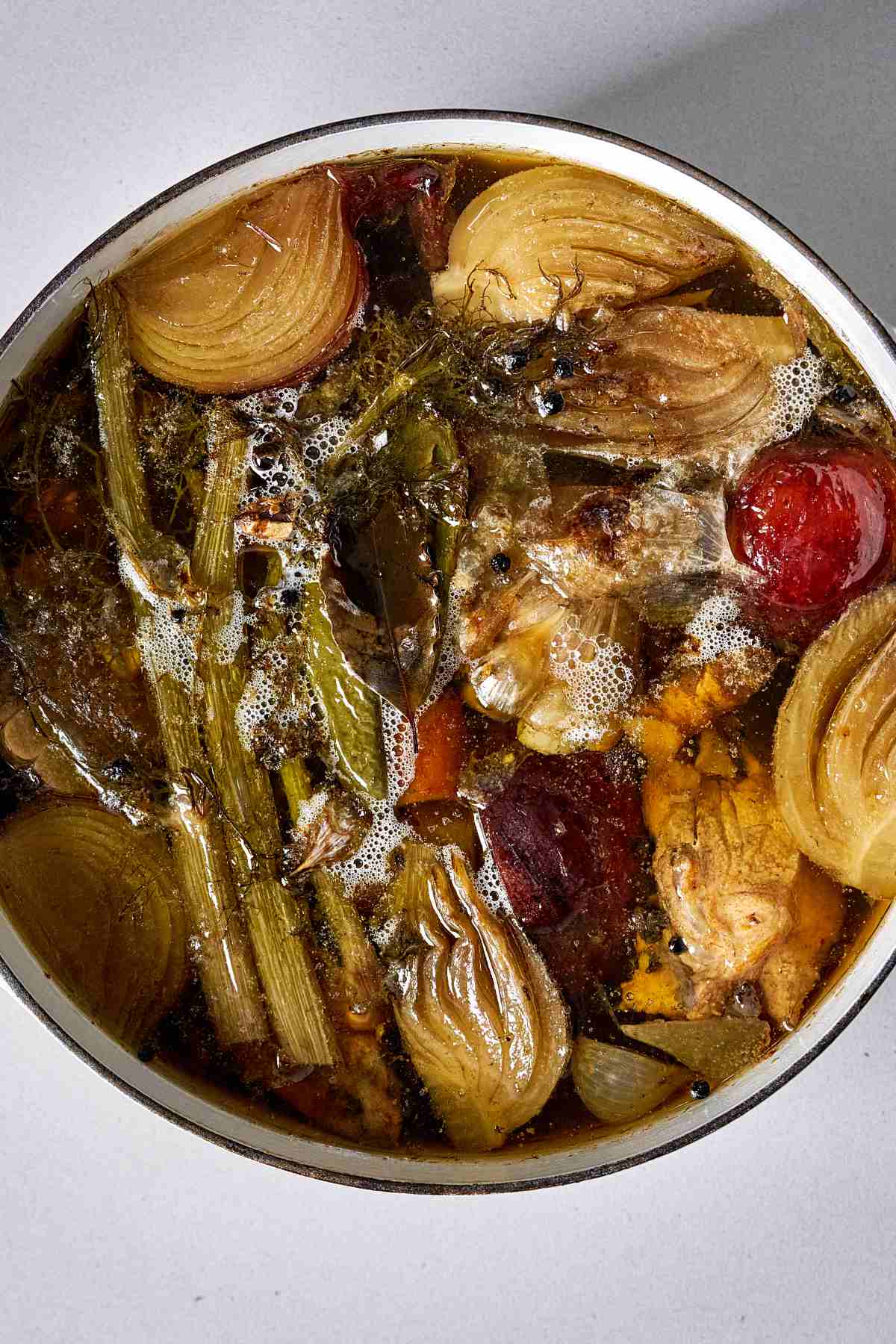
Strain to remove all the chicken and vegetables. Season with salt or soy sauce, if you’d like (optional).
Make Chicken Stock in an Instant Pot
Add all your chicken bones and vegetable ingredients to an Instant Pot. Cover all the ingredients with water, using at least 3 quarts of water. Bring the water to a simmer. Spoon off any foam that arises to the surface.
Lock the lid and cook on high pressure for 40 minutes, then release the pressure manually. Strain to remove all the chicken and vegetables. Season with salt or soy sauce, if you’d like (optional).
Make Chicken Stock in a Slow Cooker
Add all your chicken bones and vegetable ingredients to a slow cooker.
Cover all the ingredients with water and put the lid on. Bring the water to a simmer over high, then turn the slow cooker to the low setting. Spoon off any foam that arises to the surface.
Leave for a minimum of 8 hours and up to 48 hours.
Make sure to monitor the water reduction and add more when necessary – there should always be at least a few quarts of liquid in the pot.
Strain to remove all the chicken and vegetables. Season with salt or soy sauce, if you’d like (optional).
Bone broth vs. stock. What’s the difference?
Bone broth, stock, and regular broth use the same ingredients but have a different cooking time. Bone broth & bone stock are cooked much longer than regular broth…usually as long as 24-48 hours. Bone broth and bone stock result in different liquids to regular broth because the added cook time allows for all the collagen, marrow, etc. to seep out of the bones and add their nutrients to the liquid that you then drink or eat.
Broth is generally a lighter, more flavorful liquid whereas stock is much thicker, and is more often used as a base for sauces and soups.
Tips for Correct Storage
- Here are some top tips for safely storing your homemade chicken stock:
- Allow your chicken stock to cool down to room temperature before attempting to store it.
- Always store the chicken stock in an airtight container. A large mason jar works well, or a sealable silicone container.
- Store chicken stock in the fridge and safely use it for up to 5 days.
- Freeze chicken stock, which will be safe for up to 6 months.
When freezing stock, I use silicone molds like Souper Cubes freezer trays.
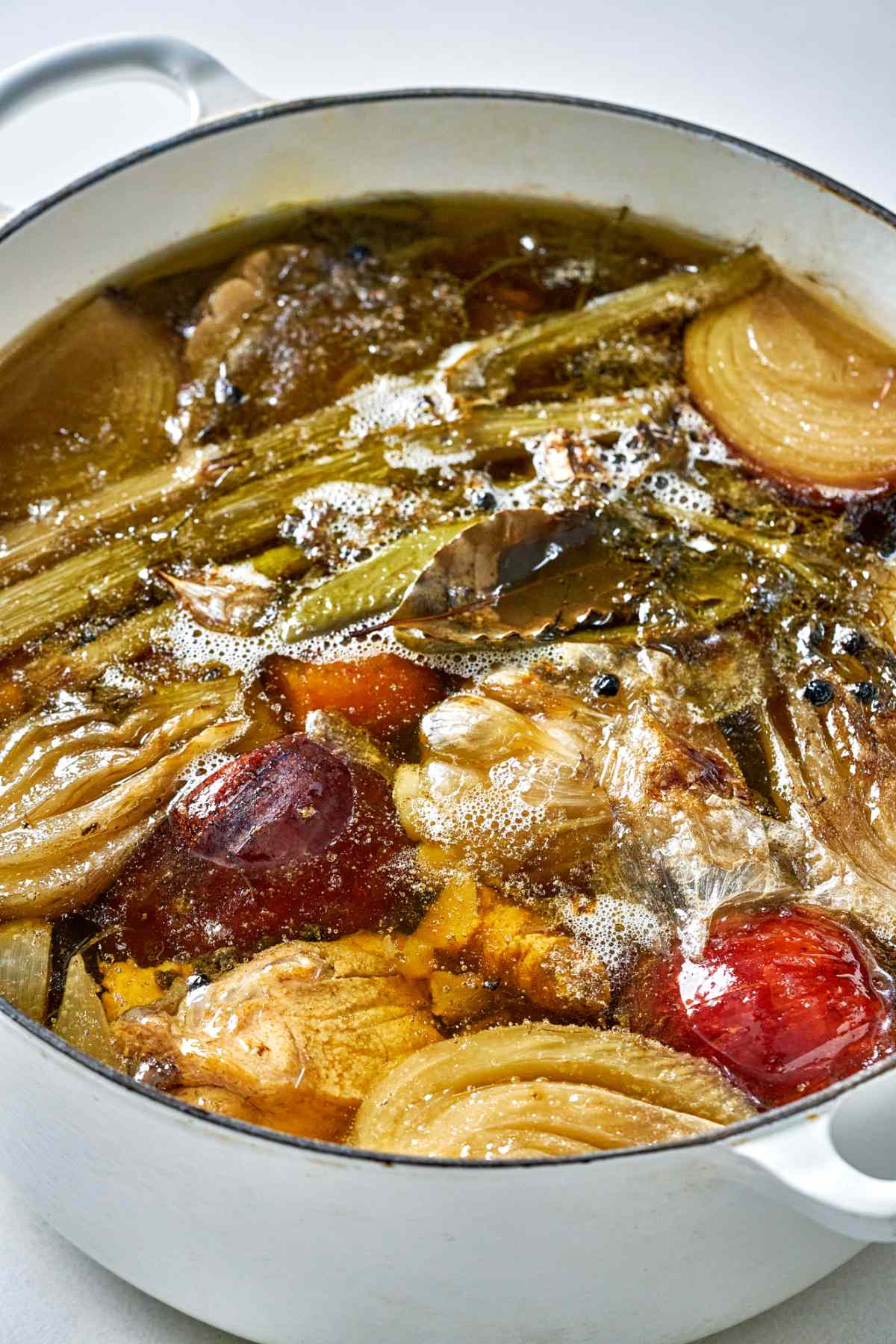
Recipes that Use Chicken Stock
Continue to level up your cooking game by using your stock in these homemade fall recipes.
★ Did you make this recipe? Please give it a star rating below!★
I love hearing from you! You can also FOLLOW ME on INSTAGRAM, TIKTOK, and PINTEREST to see more delicious food and what I’m up to.
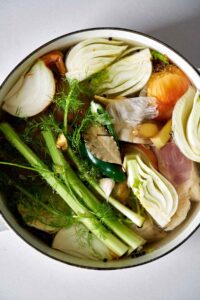
Easy Chicken Stock Recipe
Print Recipe SaveIngredients
- 4-6 chicken backbones or 3 lbs. of chicken, or 3 lbs. of chicken bones, or leftover chicken bones from a cooked whole bird
- 1 bulb fennel quartered
- 1 onion quartered
- 1 bay leaf
- 1 tbsp black peppercorns
- 3 inches fresh ginger sliced
- 1 head garlic cut in half lengthwise
- 1 large carrot
- 1 jalapeño optional, or use half
- water
- salt to taste, or soy sauce/aminos
Instructions
On the stovetop
- Add all your chicken bones and vegetable ingredients to a stock pot. Make sure the pot can hold at least 6 quarts, preferably 8.
- Cover all the ingredients with water. Bring the water to a boil, then reduce until it's lightly simmering. Spoon off any foam that arises to the surface.
- Cover with the lid of the stock pot and leave for a minimum of 4 hours, and up to 48 hours. I have found my preference is around 20 hours.
- Strain to remove all the chicken and vegetables. Season with salt or soy sauce, if you'd like (optional).
In an Instant Pot
- Add all your chicken bones and vegetable ingredients to an Instant Pot.
- Cover all the ingredients with water, using at least 3 quarts of water. Bring the water to a simmer. Spoon off any foam that arises to the surface.
- Lock the lid and cook on high pressure for 40 minutes, then release the pressure manually.
- Strain to remove all the chicken and vegetables. Season with salt or soy sauce, if you'd like (optional).
In a slow cooker
- Add all your chicken bones and vegetable ingredients to a slow cooker.
- Cover all the ingredients with water and put the lid on. Bring the water to a simmer over high, then turn the slow cooker to the low setting. Spoon off any foam that arises to the surface.
- Leave for a minimum of 8 hours and up to 48 hours.
- Strain to remove all the chicken and vegetables. Season with salt or soy sauce, if you'd like (optional).

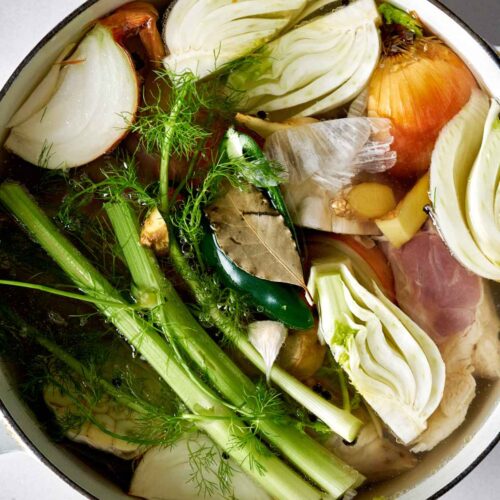
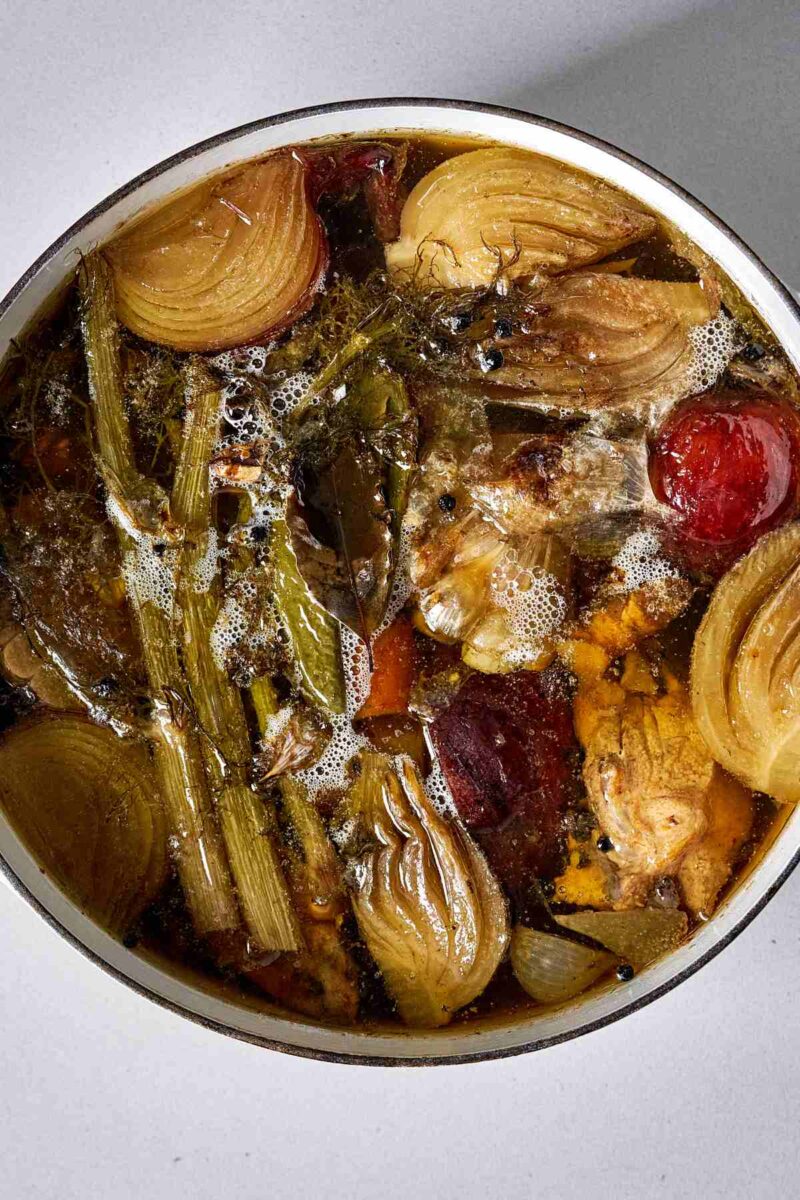
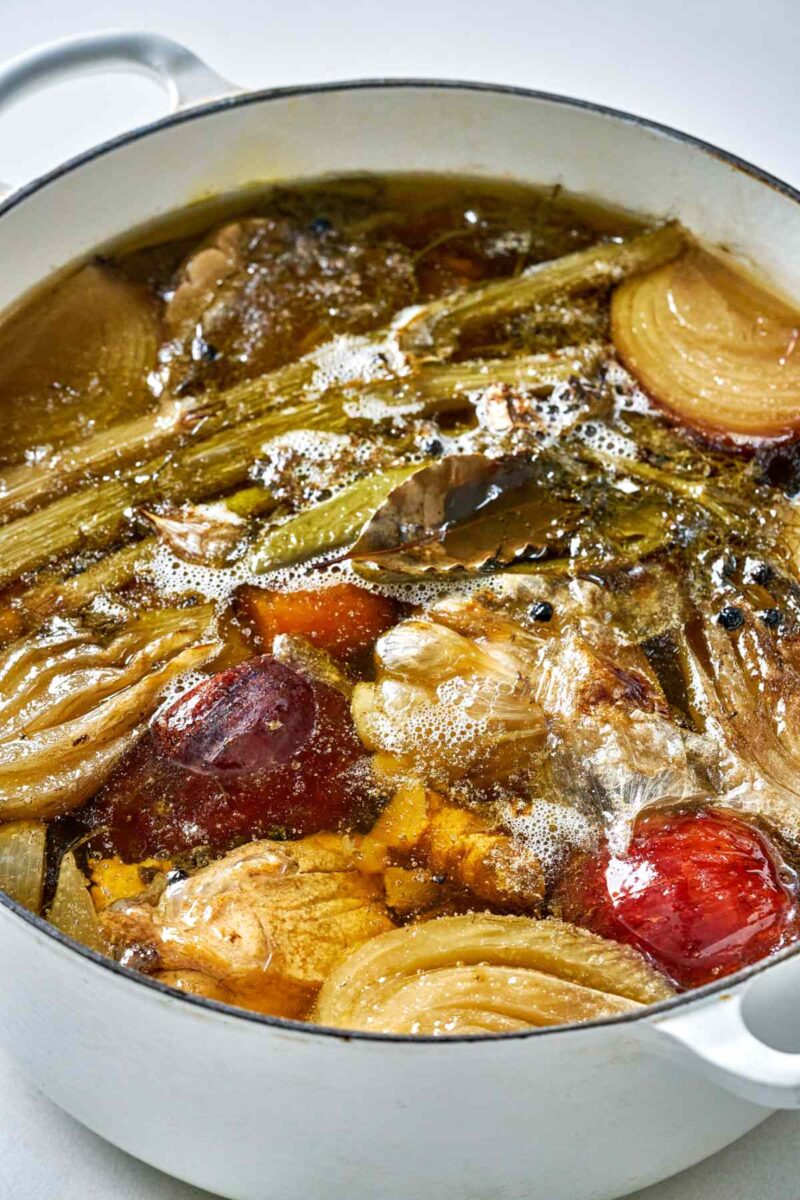
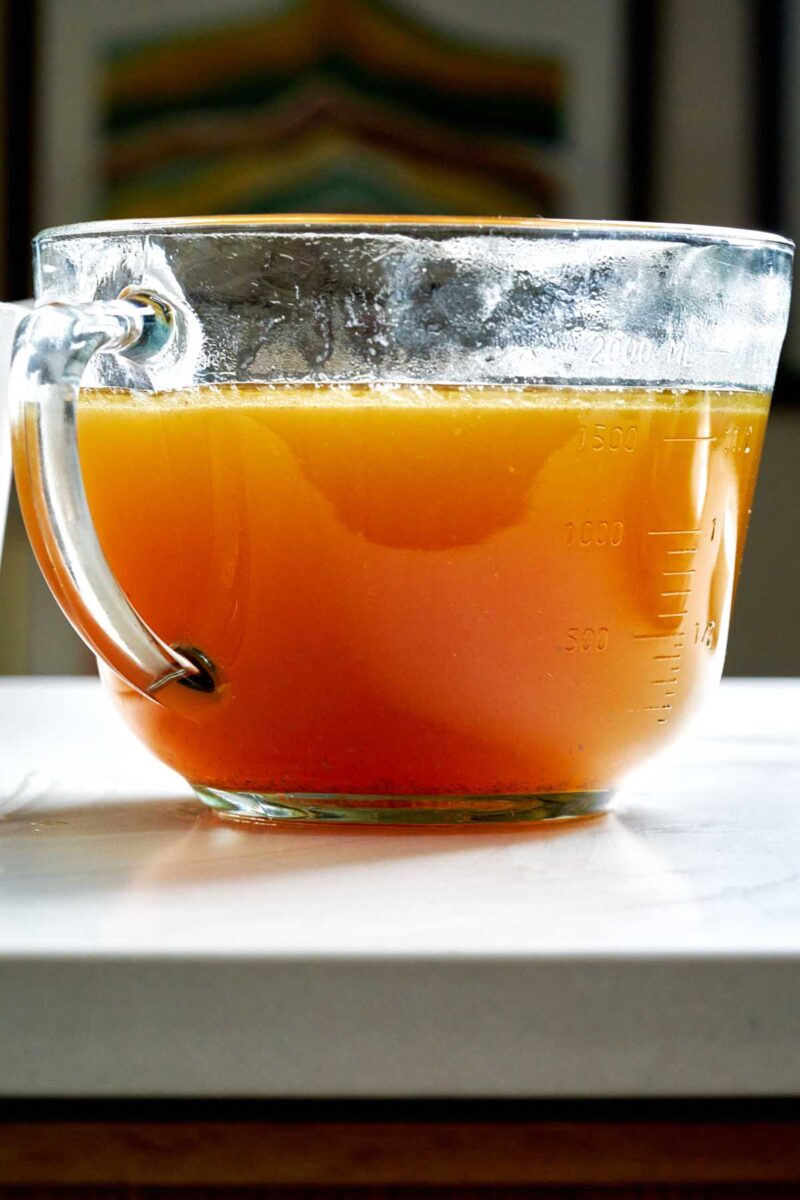
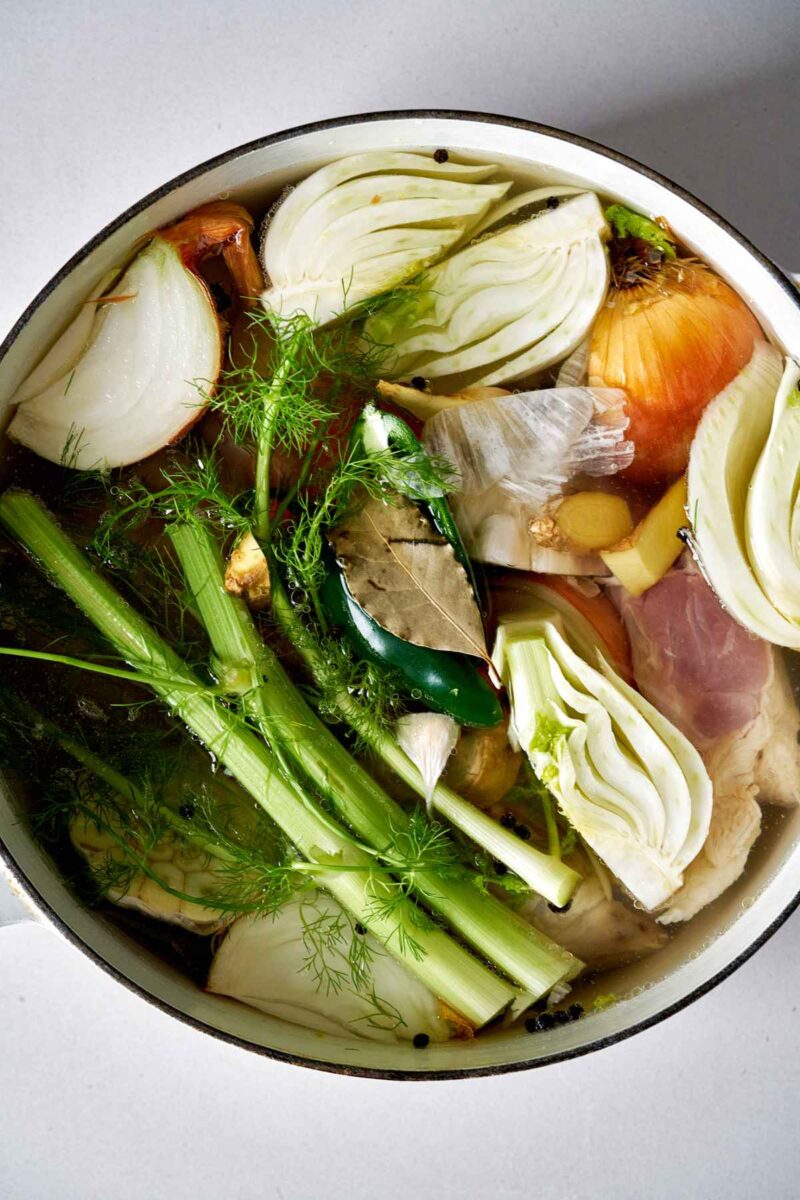
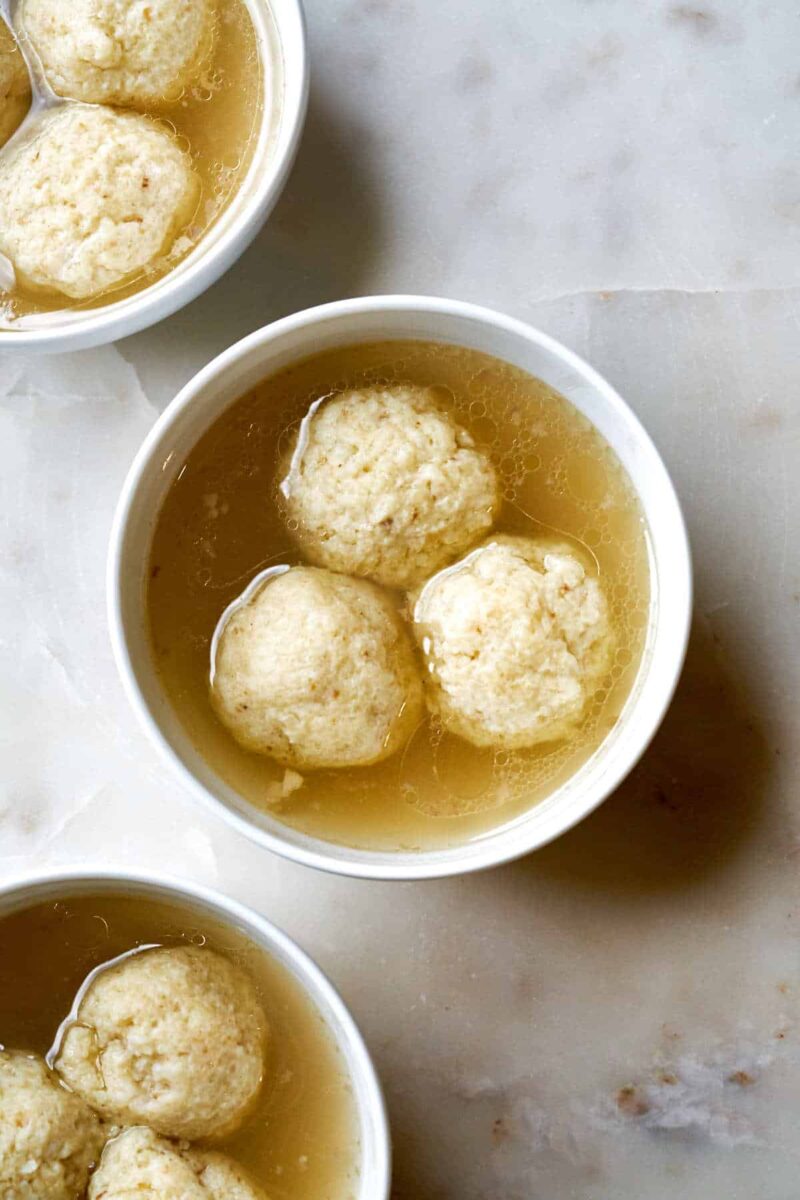

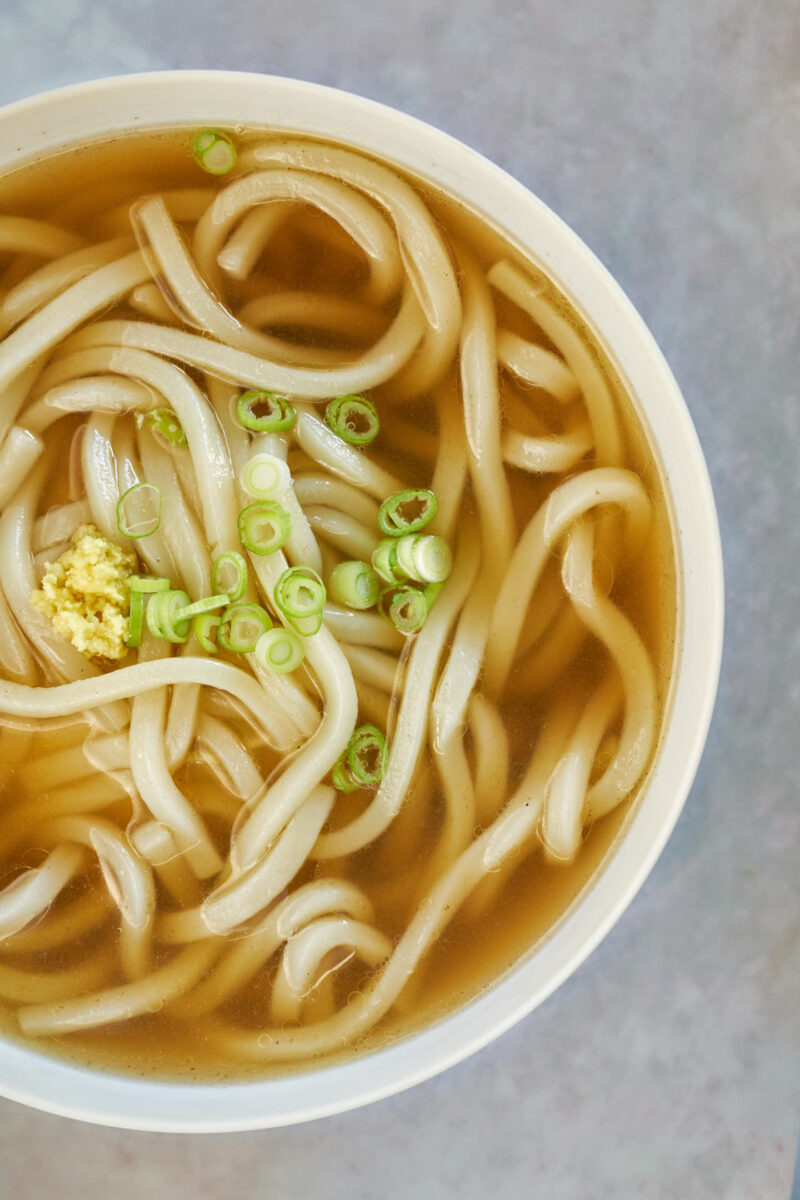
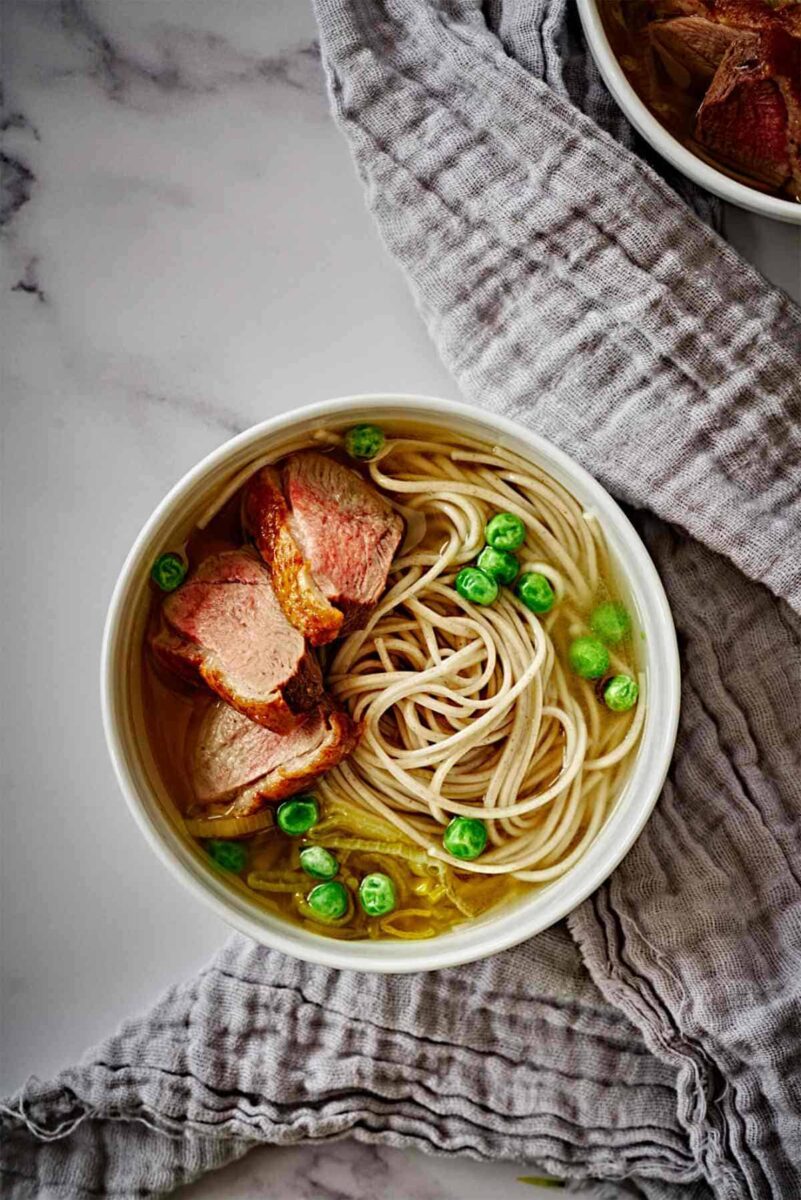
Can you use a crock pot?
Absolutely.
I would have added celery, carrots, and onions to this bone broth. Cook it the way I tells you too
I am making it now. Will come back in 48 hours to tell you how it turned out.
Those are great additions in this one, Donna… can’t wait to hear what you think!
Based on the fact that you never came back I have begun to assume the absolute worst. You were a true culinary visionary Donna and ypur absence is felt. We miss you Donna!
hee hee yeah
Just say NO to carrots and potatoes in most soups and broths
Eff celery in broth too
Use diced zucchini
chopped kale
chopped Swiss chard
so light in flavors high in nut’s
Allows the bone and collagen to stand on their own without the interference of potatoes, carrots and celery that don’t reduce to softness in the broth and kind of ruin it. In my opinion.
Giving just a piece of my mind
with light, love and levity
Helly A.